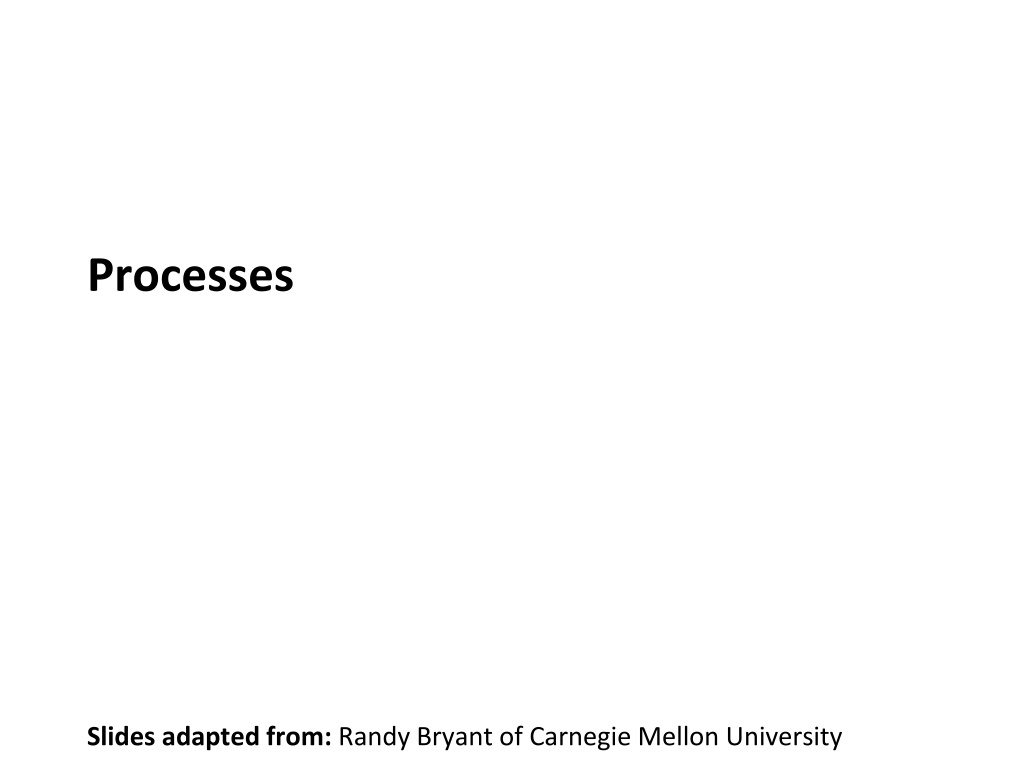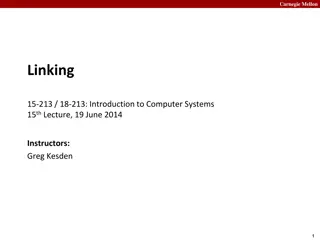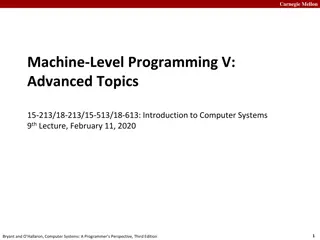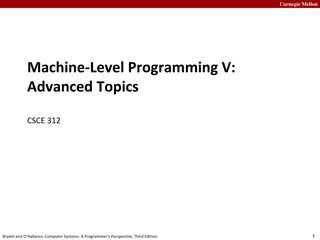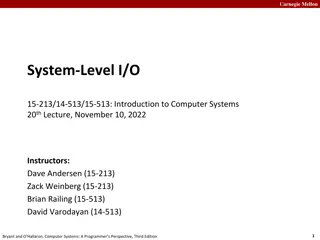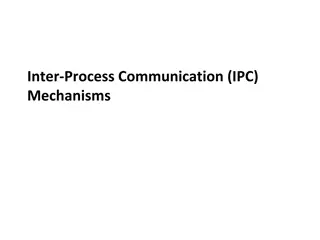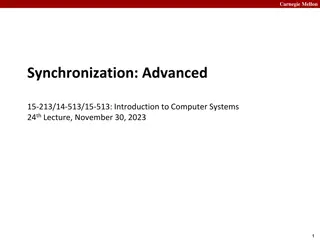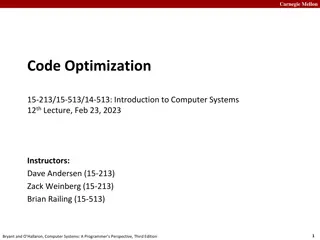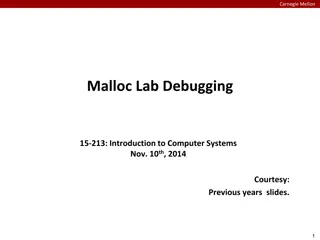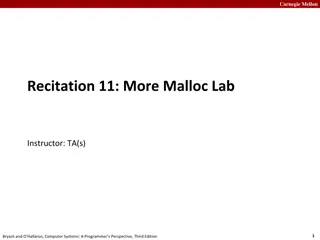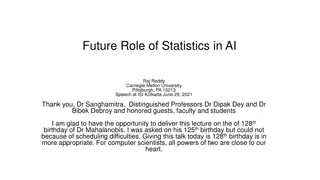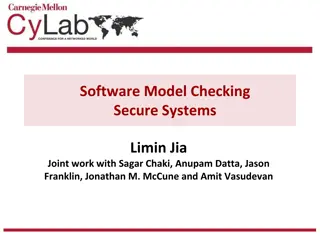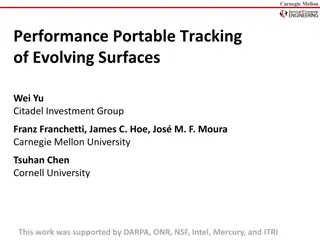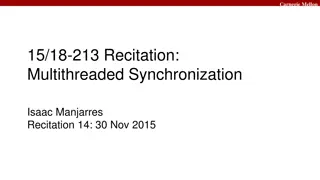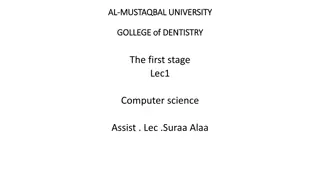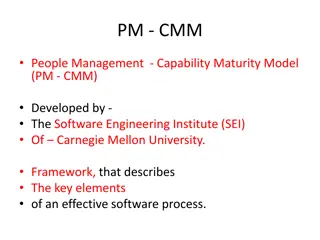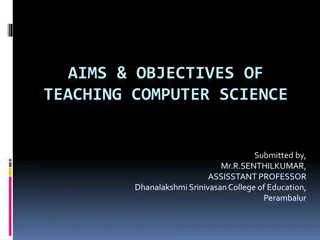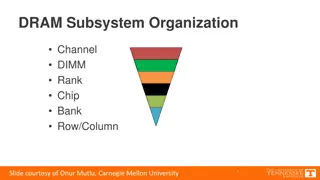Understanding Processes in Computer Science at Carnegie Mellon University
Processes in computer science at Carnegie Mellon University are explored, defining a process as an instance of a running program. The illusions of logical control flow and private virtual address spaces are maintained for each program. Components of a process include address space, processor state, and OS resources, showcasing the execution state of processes and their different stages like running, ready, and waiting. Virtual memory and process address space are key concepts discussed in detail.
Download Presentation

Please find below an Image/Link to download the presentation.
The content on the website is provided AS IS for your information and personal use only. It may not be sold, licensed, or shared on other websites without obtaining consent from the author. Download presentation by click this link. If you encounter any issues during the download, it is possible that the publisher has removed the file from their server.
E N D
Presentation Transcript
Carnegie Mellon Processes Slides adapted from: Randy Bryant of Carnegie Mellon University
Carnegie Mellon A program is the static executable, and is different from a process. Do not use program to talk about a process ! Processes Definition: A process is an instance of a running program. One of the most profound ideas in computer science Not the same as program or processor Process provides each program with two key abstractions: Logical control flow Each program seems to have exclusive use of the CPU Private virtual address space Each program seems to have exclusive use of main memory How are these illusions maintained? Process executions interleaved (multitasking) Address spaces managed by virtual memory system
Carnegie Mellon What is a process? A process is the OS's abstraction for execution A process represents a single running application on the system Process has three main components: 1. Address space The memory that the process can access Consists of various pieces: the program code, static variables, heap, stack, etc. 2. Processor state The CPU registers associated with the running process Includes general purpose registers, program counter, stack pointer, etc. 3. OS resources Various OS state associated with the process Examples: open files, network sockets, etc. CPU state %rax, . %rsp, %rip CC Address space Code Vars Heap Libraries Stack OS resources Open file info Network sockets ..
Carnegie Mellon Process Address Space 0xFFFFFFFF Virtual memory of a process includes the code of the running program the data of the running program (static variables and heap) the execution stack storing local variables and saved registers for each procedure call (Reserved for OS) Stack Stack pointer Address space Heap Uninitialized vars (BSS segment) Initialized vars (data segment) Code Program counter (text segment) 0x00000000
Carnegie Mellon Process Address Space 0xFFFFFFFF This is the process's own view of the address space physical memory may not be laid out this way at all. The virtual memory system provides this illusion to each process. (Reserved for OS) Stack Stack pointer Address space Heap Uninitialized vars (BSS segment) Initialized vars (data segment) Code Program counter (text segment) 0x00000000
Carnegie Mellon Execution State (context) of a Process Each process has an execution state (context) Indicates what the process is currently doing Running: Process is currently using the CPU Ready: Currently waiting to be assigned to a CPU That is, the process could be running, but another process is using the CPU Waiting (or sleeping): Process is waiting for an event Such as completion of an I/O, a timer to go off, etc. Why is this different than ready ? As the process executes, it moves between these states What state is the process in most of the time?
Carnegie Mellon Process State (Context) Transitions What causes schedule and unschedule transitions? create New Ready I/O done unschedule schedule Waiting kill or exit I/O, page fault, etc. Terminated Running
Carnegie Mellon Process Control Block OS maintains a Process Control Block (PCB) for each process The PCB is a big data structure with many fields: Process ID User ID Execution state ready, running, or waiting Saved CPU state CPU registers saved the last time the process was suspended. OS resources Open files, network sockets, etc. Memory management info Scheduling priority Give some processes higher priority than others Accounting information Total CPU time, memory usage, etc.
Carnegie Mellon struct task_struct {/* these are hardcoded - don't touch */ volatile long state; /* -1 unrunnable, 0 runnable, >0 stopped */ long counter; long priority; unsigned long signal; unsigned long blocked; /* bitmap of masked signals */ unsigned long flags; /* per process flags, defined below */ int errno; long debugreg[8]; /* Hardware debugging registers */ struct exec_domain *exec_domain; /* various fields */ struct linux_binfmt *binfmt; struct task_struct *next_task, *prev_task; struct task_struct *next_run, *prev_run; unsigned long saved_kernel_stack; unsigned long kernel_stack_page; int exit_code, exit_signal; /* ................ */ int pid; struct wait_queue *wait_chldexit; unsigned short uid,euid,suid,fsuid; unsigned short gid,egid,sgid,fsgid; unsigned long timeout, policy, rt_priority; /* file system info */ int link_count; struct tty_struct *tty; /* NULL if no tty */ /* ipc stuff */ struct sem_undo *semundo; struct sem_queue *semsleeping;/* ldt for this task - used by Wine. If NULL, default_ldt is used */ /* ................ */ struct desc_struct *ldt;/* tss for this task */ struct thread_struct tss;/* filesystem information */ struct fs_struct *fs;/* open file information */ struct files_struct *files;/* memory management info */ struct mm_struct *mm;/* signal handlers */ struct signal_struct *sig; /* ................ */ } PCB in Linux Each task_struct dat a structure describes a process or task in the system.
Carnegie Mellon Context Switching Processes are managed by a shared chunk of OS code called the kernel Important: the kernel is not a separate process, but rather runs as part of some user process Control flow passes from one process to another via a context switch Process A Process B user code context switch kernel code Time user code context switch kernel code user code
Carnegie Mellon Context Switching in Linux Process A is happily running along... Process A time
Carnegie Mellon Context Switching in Linux Process A 1) Timer interrupt fires 2) PC saved on stack User Kernel Timer interrupt handler time
Carnegie Mellon Context Switching in Linux Process A 1) Timer interrupt fires 2) PC saved on stack User Kernel 3) Rest of CPU state saved in PCB Timer interrupt handler 4) Call schedule() routine Scheduler time
Carnegie Mellon Context Switching in Linux Process A Process B 1) Timer interrupt fires 7) Return from interrupt handler process CPU state restored 2) PC saved on stack User Kernel 3) Rest of CPU state saved in PCB Timer interrupt handler Timer interrupt handler 6) Resume Process B (suspended within timer interrupt handler!) 4) Call schedule() routine 5) Decide next process to run Scheduler time
Carnegie Mellon Context Switch Overhead Context switches are not cheap Generally have a lot of CPU state to save and restore Also must update various flags in the PCB Picking the next process to run scheduling is also expensive Context switch overhead in Linux About 5-7 usec (u: micro) This is equivalent to about 10,000 CPU cycles!
Carnegie Mellon State Queues The OS maintains a set of state queues for each process state Separate queues for ready and waiting states Generally separate queues for each kind of waiting process One queue for processes waiting for disk I/O, another for network I/O, etc. PID 4277 State: Ready PID 4391 State: Ready Ready queue PC PC Registers Registers PID 4923 State: Waiting PID 4110 State: Waiting PID 4002 State: Waiting Disk I/O queue PC PC PC Registers Registers Registers
Carnegie Mellon State Queue Transitions PCBs move between these queues as their state changes When scheduling a process, pop the head off of the ready queue When I/O has completed, move PCB from waiting queue to ready queue PID 4277 State: Ready PID 4391 State: Ready PID 4923 State: Ready Ready queue PC PC PC Registers Registers Registers PID 4923 State: Waiting PID 4110 State: Waiting PID 4002 State: Waiting Disk I/O queue PC PC PC Registers Registers Registers Disk I/O completes
Carnegie Mellon Concurrent Processes Each process is a logical control flow. Two processes run concurrently (are concurrent) if their flows overlap in time Otherwise, they are sequential Examples (running on single core): Concurrent: A & B, A & C Sequential: B & C Process A Process B Process C Time
Carnegie Mellon User View of Concurrent Processes Control flows for concurrent processes are physically disjoint in time However, we can think of concurrent processes as running in parallel with each other Process A Process B Process C Time
Carnegie Mellon Creating Processes Parent process creates a new running child process by calling fork
Carnegie Mellon Creating Processes Parent process creates a new running child process by calling fork int fork(void) Returns 0 to the child process, child s PID to parent process Child is almost identical to parent: Child get an identical (but separate) copy of the parent s virtual address space. Child gets identical copies of the parent s open file descriptors Child has a different PID than the parent fork is interesting (and often confusing) because it is called once but returns twice https://www.cdn.geeksforgeeks.org/fork-system-call/
Carnegie Mellon fork Example Call once, return twice int main(int argc, char** argv) { pid_t pid; int x = 1; Concurrent execution Can t predict execution order of parent and child pid = fork(); if (pid == 0) { /* Child */ printf("child : x=%d\n", ++x); return 0; } /* Parent */ printf("parent: x=%d\n", --x); return 0; } fork.c linux> ./fork parent: x=0 child : x=2 linux> ./fork child : x=2 parent: x=0 linux> ./fork parent: x=0 child : x=2 linux> ./fork parent: x=0 child : x=2
Carnegie Mellon fork Example int main(int argc, char** argv) { pid_t pid; int x = 1; Call once, return twice Concurrent execution Can t predict execution order of parent and child pid = fork(); if (pid == 0) { /* Child */ printf("child : x=%d\n", ++x); printf("child : x=%d\n", ++x); return 0; } Duplicate but separate address space x has a value of 1 when fork returns in parent and child Subsequent changes to x are independent /* Parent */ printf("parent: x=%d\n", --x); printf("parent: x=%d\n", --x); return 0; } fork.c linux> ./fork parent: x=0 child : x=2 parent: x=-1 linux> ./fork parent: x=0 child : x=2 child : x=3
Carnegie Mellon Modeling fork with Process Graphs A process graph is a useful tool for capturing the partial ordering of statements in a concurrent program: Each vertex is the execution of a statement a -> b means a happens before b Edges can be labeled with current value of variables printf vertices can be labeled with output Each graph begins with a vertex with no in-edges Any topological sort of the graph corresponds to a feasible total ordering. Total ordering of vertices where all edges point from left to right
Carnegie Mellon Process Graph Example int main(int argc, char** argv) { pid_t pid; int x = 1; child: x=2 printf parent: x=0 Child pid = fork(); if (pid == 0) { /* Child */ printf("child : x=%d\n", ++x); return 0; } exit x==1 Parent exit main fork printf /* Parent */ printf("parent: x=%d\n", --x); return 0; } fork.c
Carnegie Mellon Interpreting Process Graphs Original graph: child: x=2 printf parent: x=0 exit x==1 exit main fork printf Feasible total ordering: Relabeled graph: e f a b e c f d a b c d Infeasible total ordering: a b f c e d
Carnegie Mellon fork Example: Two consecutive forks Bye printf Bye void fork2() { printf("L0\n"); fork(); printf("L1\n"); fork(); printf("Bye\n"); } L1 printf fork printf Bye printf Bye L1 L0 printf fork printf printf fork forks.c Feasible output: L0 L1 Bye Bye L1 Bye Bye Infeasible output: L0 Bye L1 Bye L1 Bye Bye
Carnegie Mellon fork Example: Nested forks in parent void fork4() { printf("L0\n"); if (fork() != 0) { printf("L1\n"); if (fork() != 0) { printf("L2\n"); } } printf("Bye\n"); } Bye Bye printf printf L2 L0 L1 Bye printf printf fork printf printf fork Feasible output: L0 L1 Bye Bye L2 Bye Infeasible output: L0 Bye L1 Bye Bye L2 forks.c
Carnegie Mellon fork Example: Nested forks in children void fork5() { printf("L0\n"); if (fork() == 0) { printf("L1\n"); if (fork() == 0) { printf("L2\n"); } } printf("Bye\n"); } L2 Bye printf Bye printf L1 printf fork printf L0 Bye printf printf fork Feasible output: L0 Bye L1 L2 Bye Bye Infeasible output: L0 Bye L1 Bye Bye L2 forks.c
Carnegie Mellon Why have fork() at all? Why make a copy of the parent process? Don't you usually want to start a new program instead? Where might cloning the parent be useful? Web server make a copy for each incoming connection Parallel processing set up initial state, fork off multiple copies to do work UNIX philosophy: System calls should be minimal. Don't overload system calls with extra functionality if it is not always needed. Better to provide a flexible set of simple primitives and let programmers combine them in useful ways.
Carnegie Mellon What if fork ing gets out of control? void forkbomb() { while (1) fork(); }
Carnegie Mellon Memory concerns OS aggressively tries to share memory between processes. Especially processes that are fork()'d copies of each other Copies of a parent process do not actually get a private copy of the address space... ... though that is the illusion that each process gets. Instead, they share the same physical memory, until one of them makes a change. The virtual memory system is behind these tricks. We will discuss this in much detail later in the course
Carnegie Mellon Terminating Processes Process becomes terminated for one of three reasons: Receiving a signal whose default action is to terminate (more later) Returning from the main routine Calling the exit function void exit(int status) Terminates with an exit status of status Convention: normal return status is 0, nonzero on error Another way to explicitly set the exit status is to return an integer value from the main routine atexit()registers functions to be executed upon exit void cleanup(void) { printf("cleaning up\n"); } void fork() { atexit(cleanup); fork(); exit(0); } exit is called once but never returns.
Carnegie Mellon Reaping Child Processes Idea When process terminates, it still consumes system resources Examples: Exit status, various OS tables Called a zombie Living corpse, half alive and half dead Reaping Performed by parent on terminated child (using wait or waitpid) Parent is given exit status information Kernel then deletes zombie child process What if parent doesn t reap? If any parent terminates without reaping a child, then the orphaned child will be reaped by init process (pid == 1) So, only need explicit reaping in long-running processes e.g., shells and servers
Carnegie Mellon void fork7() { if (fork() == 0) { /* Child */ printf("Terminating Child, PID = %d\n", getpid()); exit(0); } else { printf("Running Parent, PID = %d\n", getpid()); while (1) ; /* Infinite loop */ } } Zombie Example linux> ./forks 7 & [1] 6639 Running Parent, PID = 6639 Terminating Child, PID = 6640 linux> ps PID TTY TIME CMD 6585 ttyp9 00:00:00 tcsh 6639 ttyp9 00:00:03 forks 6640 ttyp9 00:00:00 forks <defunct> 6641 ttyp9 00:00:00 ps 6641 ttyp9 00:00:00 ps linux> kill 6639 [1] Terminated linux> ps PID TTY TIME CMD 6585 ttyp9 00:00:00 tcsh 6642 ttyp9 00:00:00 ps linux> ./forks 7 & [1] 6639 Running Parent, PID = 6639 Terminating Child, PID = 6640 Terminating Child, PID = 6640 linux> ps PID TTY TIME CMD 6585 ttyp9 00:00:00 tcsh 6639 ttyp9 00:00:03 forks 6640 ttyp9 00:00:00 forks <defunct> linux> ./forks 7 & [1] 6639 Running Parent, PID = 6639 forks.c ps shows child process as defunct (i.e., a zombie) Killing parent allows child to be reaped by init
Carnegie Mellon void fork8() { if (fork() == 0) { /* Child */ printf("Running Child, PID = %d\n", getpid()); while (1) ; /* Infinite loop */ } else { printf("Terminating Parent, PID = %d\n", getpid()); exit(0); } } Non- terminating Child Example forks.c linux> ./forks 8 Terminating Parent, PID = 6675 Running Child, PID = 6676 Running Child, PID = 6676 linux> ps PID TTY TIME CMD 6585 ttyp9 00:00:00 tcsh 6676 ttyp9 00:00:06 forks 6677 ttyp9 00:00:00 ps 6677 ttyp9 00:00:00 ps linux> kill 6676 linux> ps PID TTY TIME CMD 6585 ttyp9 00:00:00 tcsh 6678 ttyp9 00:00:00 ps linux> ./forks 8 Terminating Parent, PID = 6675 Terminating Parent, PID = 6675 Running Child, PID = 6676 linux> ps PID TTY TIME CMD 6585 ttyp9 00:00:00 tcsh 6676 ttyp9 00:00:06 forks linux> ./forks 8 Child process still active even though parent has terminated Must kill child explicitly, or else will keep running indefinitely
Carnegie Mellon wait: Synchronizing with Children Parent reaps a child by calling the wait function int wait(int *child_status) Suspends current process until one of its children terminates Parent Process Kernel code Exception And, potentially other user processes, including a child of parent syscall Returns
Carnegie Mellon wait: Synchronizing with Children Parent reaps a child by calling the wait function int wait(int *child_status) Suspends current process until one of its children terminates Return value is the pid of the child process that terminated If child_status!= NULL, then the integer it points to will be set to a value that indicates reason the child terminated and the exit status: Checked using macros defined in wait.h WIFEXITED, WEXITSTATUS, WIFSIGNALED, WTERMSIG, WIFSTOPPED, WSTOPSIG, WIFCONTINUED See man pages for details
Carnegie Mellon Process completion status int WIFEXITED (int status) returns a nonzero value if the child process terminated normally with exit or _exit. int WEXITSTATUS (int status) If WIFEXITED is true of status, this macro returns the low-order 8 bits of the exit status value from the child process. int WIFSIGNALED (int status) returns a nonzero value if the child process terminated because it received a signal that was not handled int WTERMSIG (int status) If WIFSIGNALED is true of status, this macro returns the signal number of the signal that terminated the child process. int WCOREDUMP (int status) Returns a nonzero value if the child process terminated and produced a core dump. int WIFSTOPPED (int status) returns a nonzero value if the child process is stopped. int WSTOPSIG (int status) If WIFSTOPPED is true of status, this macro returns the signal number of the signal that caused the child process to stop. http://www.gnu.org/software/libc/manual/html_node/Process-Completion-Status.html
Carnegie Mellon wait: Synchronizing with Children void fork9() { int child_status; HC exit if (fork() == 0) { printf("HC: hello from child\n"); exit(0); } else { printf("HP: hello from parent\n"); wait(&child_status); printf("CT: child has terminated\n"); } printf("Bye\n"); } printf CT Bye HP printf wait printf fork forks.c Feasible output(s): HC HP CT Feasible output: HC HP CT Bye Bye Infeasible output: HP CT Bye HC HP HC CT Bye
Carnegie Mellon Another wait Example If multiple children completed, will take in arbitrary order Can use macros WIFEXITED and WEXITSTATUS to get information about exit status void fork10() { pid_t pid[N]; int i, child_status; for (i = 0; i < N; i++) if ((pid[i] = fork()) == 0) { exit(100+i); /* Child */ } for (i = 0; i < N; i++) { /* Parent */ pid_t wpid = wait(&child_status); if (WIFEXITED(child_status)) printf("Child %d terminated with exit status %d\n", wpid, WEXITSTATUS(child_status)); else printf("Child %d terminate abnormally\n", wpid); } } forks.c
Carnegie Mellon waitpid: Waiting for a Specific Process pid_t waitpid(pid_t pid, int *status, int options) Suspends current process until specific process terminates Various options (see man page) void fork11() { pid_t pid[N]; int i; int child_status; for (i = 0; i < N; i++) if ((pid[i] = fork()) == 0) exit(100+i); /* Child */ for (i = N-1; i >= 0; i--) { pid_t wpid = waitpid(pid[i], &child_status, 0); if (WIFEXITED(child_status)) printf("Child %d terminated with exit status %d\n", wpid, WEXITSTATUS(child_status)); else printf("Child %d terminate abnormally\n", wpid); } } forks.c
Carnegie Mellon execve: Loading and Running Programs int execve(char *filename, char *argv[], char *envp[]) Loads and runs in the current process: Executable file filename Can be object file or script file beginning with #!interpreter (e.g., #!/bin/bash) with argument list argv By convention argv[0]==filename and environment variable list envp name=value strings (e.g., USER=droh) getenv, putenv, printenv Overwrites code, data, and stack Retains PID, open files and signal context Called once and never returns except if there is an error
Carnegie Mellon fork() and execve() execve() does not fork a new process! Rather, it replaces the address space and CPU state of the current process Loads the new address space from the executable file and starts it from main() So, to start a new program, use fork() followed by execve()
Carnegie Mellon execl and exec Family int execl(char *path, char *arg0, char *arg1, , 0) Loads and runs executable at path with args arg0, arg1, path is the complete path of an executable object file By convention,arg0is the name of the executable object file Real arguments to the program start with arg1, etc. List of args is terminated by a (char *)0argument Environment taken from char **environ, which points to an array of name=value strings: USER=ganger LOGNAME=ganger HOME=/afs/cs.cmu.edu/user/ganger Returns -1 if error, otherwise doesn t return! Family of functions includes execv, execve (base function), execvp, execl, execle, and execlp
Carnegie Mellon exec: Using fork followed by exec int main(int argc, char **argv) { int rv; if (fork()) { /* Parent process */ wait(&rv); } else { /* Child process */ char *newargs[3]; printf( Hello, I am the child process.\n ); newargs[0] = /bin/echo ; /* Convention! Not required!! */ newargs[1] = some random string ; newargs[2] = NULL; /* Indicate end of args array */ if (execv( /bin/echo , newargs)) { printf( warning: execve returned an error.\n ); exit(-1); } printf( Child process should never get here\n ); exit(42); } }
Carnegie Mellon exec() function family The suffix s determine the arguments l : arguments are passed as a list of strings to the main() v : arguments are passed as an array of strings to the main() p : path/s to search for the new running program e : the environment can be specified by the caller One can mix them with different combinations int execl(const char *path, const char *arg, ...); int execlp(const char *file, const char *arg, ...); int execle(const char *path, const char *arg, ..., char * const envp[]); int execv(const char *path, char *const argv[]); int execve(const char *path, char *const argv[], char *const envp[]); int execvp(const char *file, char *const argv[]); int execvpe(const char *file, char *const argv[], char *const envp[]); The initial argument is always the name of a file to be executed.
Carnegie Mellon Environment variables An environment variable is a dynamic-named value that can affect the way running processes will behave on a computer. They are part of the environment in which a process runs. For example, a running process can query the value of the TEMP environment variable to discover a suitable location to store temporary files, or the HOME or USERPROFILE variable to find the directory structure owned by the user running the process In Unix, use printenv in your shell to get the full list. https://en.wikipedia.org/wiki/Environment_variable
Carnegie Mellon Linux Process Hierarchy [0] init [1] Daemon e.g. httpd Login shell Login shell Child Child Child Note: you can view the hierarchy using the Linux pstree command Grandchild Grandchild
Carnegie Mellon Summary Process is an instance of program in execution At any given time, a system has multiple active processes Only one can execute at a time, though Each process appears to have total control of processor + private memory space Spawning processes Call to fork One call, two returns Process completion Call exit One call, no return Reaping and waiting for Processes Call wait or waitpid Loading and running Programs Call execl(or variant) One call, (normally) no return
